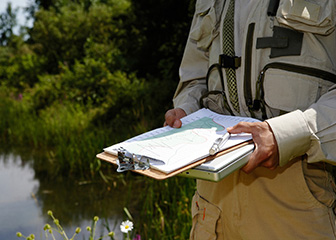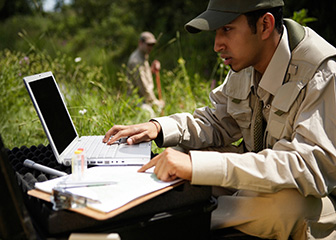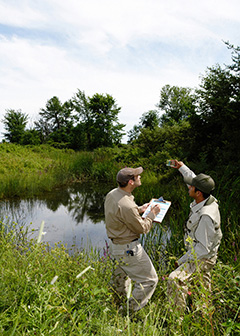What Conservation Scientists and Foresters Do
About this section

Conservation scientists and foresters monitor forest-cleared lands to ensure that they are suitable for future use.
Conservation scientists and foresters manage overall land quality of forests, parks, rangelands, and other natural resources.
Duties
Conservation scientists and foresters typically do the following:
- Monitor forestry and conservation activities to assure compliance with government regulations
- Establish plans for managing forest lands and resources
- Supervise activities of other forestry and conservation workers
- Choose and prepare sites for new trees using controlled burning, bulldozers, or herbicides to clear land
- Negotiate terms and conditions for forest harvesting and land-use contracts
- Direct and participate in forest-fire suppression
- Determine ways to remove timber with minimum environmental damage
- Monitor forest-cleared lands to ensure that they are suitable for future use
Conservation scientists manage, improve, and protect the country's natural resources. They work with landowners and federal, state, and local governments to devise ways to use and improve the land while safeguarding the environment. Conservation scientists advise farmers, farm managers, and ranchers on how they can improve their land for agricultural purposes and control erosion.
Foresters have a wide range of duties, and their responsibilities vary depending on their employer. Some primary duties of foresters include drawing up plans to regenerate forested lands, monitoring the progress of those lands, and supervising tree harvests. They also come up with plans to keep forests free from disease, harmful insects, and damaging wildfires.
Foresters may choose and direct the preparation of sites on which trees will be planted. They advise on the type, number, and placement of trees to be planted. When the trees reach a certain size, foresters decide which trees should be harvested and sold to sawmills.
Many conservation scientists and foresters supervise forest and conservation workers and technicians, directing their work and evaluating their progress. For more information, see the profiles on forest and conservation workers and forest and conservation technicians.
Conservation scientists and foresters evaluate data on forest and soil quality, assessing damage to trees and forest lands caused by fires and logging activities. In addition, they lead activities such as fire suppression and planting seedlings. Fire suppression activities include measuring how quickly fires will spread and how successful the planned suppression activity turns out.
Scientists and foresters use their skills to determine a fire’s impact on a region’s environment. Communication with firefighters and other forest workers is an important component of fire suppression activities because the information that conservation scientists and foresters give can change how firefighters work.
Conservation scientists and foresters use a number of tools to perform their jobs. They use clinometers to measure the heights of trees, diameter tapes to measure a tree’s circumference, and increment borers and bark gauges to measure the growth of trees so that timber volumes can be computed and growth rates estimated.
In addition, conservation scientists and foresters often use remote sensing (aerial photographs and other imagery taken from airplanes and satellites) and geographic information systems (GIS) data to map large forest or range areas and to detect widespread trends of forest and land use. They make extensive use of hand-held computers and global positioning systems (GPS) to study these maps.
The following are some types of conservation scientists and foresters:
Procurement foresters buy timber by contacting local forest owners and negotiating a sale. This activity typically involves taking inventory on the type, amount, and location of all standing timber on the property. Procurement foresters then appraise the timber’s worth, negotiate its purchase, and draw up a contract. The forester then subcontracts with loggers or pulpwood cutters to remove the trees and to help lay out roads to get to the timber.
Other foresters, mostly in the federal government, study issues facing forests and related natural resources. They may study issues such as tree improvement and harvesting techniques, global climate change, improving wildlife habitats, and protecting forests from pests, diseases, and wildfires.
Urban foresters live and work in larger cities and manage urban trees. They are concerned with quality-of-life issues, including air quality, shade, and storm water runoff.
Conservation education foresters train teachers and students about issues facing forest lands.
Two of the most common types of conservation scientists are range managers and soil conservationists.
Range managers, also called range conservationists, protect rangelands to maximize their use without damaging the environment. Rangelands contain many natural resources and cover hundreds of millions of acres in the United States, mainly in the western states and Alaska.
Range managers may inventory soils, plants, and animals; develop resource management plans; help to restore degraded ecosystems; or help manage a ranch. They also maintain soil stability and vegetation for uses such as wildlife habitats and outdoor recreation. Like foresters, they work to prevent and reduce wildfires and invasive animal species.
Soil and water conservationists give technical help to people who are concerned with the conservation of soil, water, and related natural resources. For private landowners, they develop programs to make the most productive use of land without damaging it. They also help landowners with issues such as dealing with erosion. They help private landowners and governments by advising on water quality, preserving water supplies, preventing groundwater contamination, and conserving water.









